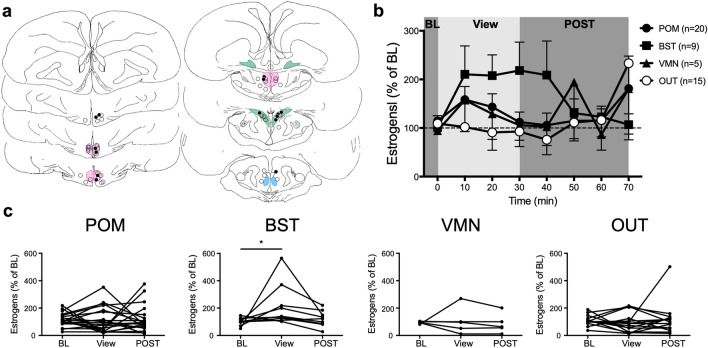Figure 5.
Visual access to a female increases estrogen concentrations in the BST. (a) Location of the dialysis probes. IN probes are either within or touching the colored zones representing brain regions expressing aromatase. See legend of Fig. 1 for the definition of different brain areas. Black and open circles respectively represent birds in which estrogen concentrations did or did not increase above 150% of the baseline (BL) during the visual interaction period (last sample). (b) Time course of the mean percentage of estrogen concentration in the dialysate (based on the mean concentration measured in the last 3 BL samples). Friedman ANOVA: POM, χ2n=20 = 9.241, p = 0.2358; BST, χ2n=9 = 14.69, p = 0.0402; VMN, χ2n=5 = 13.28, p = 0.0655; OUT, χ2n=15 = 13.15, p = 0.0686. No post hoc comparison reached statistical significance. (c) Individual percent changes in estrogen concentration relative to BL in the three sampling periods for individuals whose probe was in the POM, BST, VMN, or outside any nuclei expressing aromatase (OUT). Friedman ANOVA: POM: χ2n=20 = 1.532, p = 0.4649; BST: χ2n=9 = 7.0, p = 0.0249, No post hoc comparison reached statistical significance; VMN: χ2n=5 = 6.000, p = 0.0694; OUT: χ2n=15 = 0.3415, p = 0.8430. View: Period when the male has visual access to the female, POST: Period after the behavioral test. The baseline amounts of estrogens per sample in this experiment ranged between 0.026 and 1.463 pg per sample (10 µl; Mean ± S.E.M. = 0.159 ± 0.027, n = 49). Panel A is composed of home made drawings onto which probe positions were reported using Graphic for Mac (https://graphic.com/mac/), other panels were created with Graph Pad Prism 8 (https://www.graphpad.com/scientific-software/prism/). All panels were assembled in Graphic.

